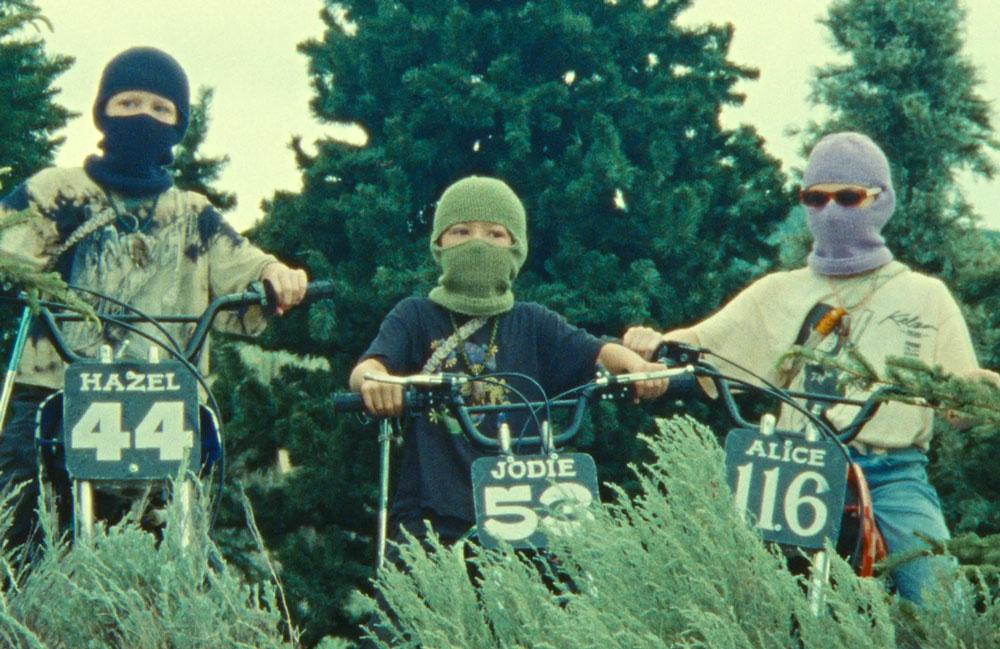The coming-of-age-summer movie is a cornerstone in narratives about young people—roaming outdoors under the hot sun, the innocent early traces of young romance, camaraderie among friends. This mix of peril and play has lingered in the adolescent cinematic imagination for so long that it’s difficult to conceive of ways in which it can be innovated upon. By channeling classic children’s adventure films and fantasy role-playing games, filmmaker Weston Razooli has managed to innovate upon these tropes in his debut feature Riddle of Fire, and he has also potentially made a future cult classic in the process.
Riddle of Fire introduces us to the Three Immortal Reptiles, a rambunctious trio of tweens consisting of Hazel (Charlie Stover), his little brother Jodie (Skyler Peters), and their friend Alice (Phoebe Ferro). Clad in ski masks and wielding paintball guns, they zip around their woodsy hometown of Ribbon, Wyoming, on dirtbikes and sneak into a warehouse to steal a video game console called Angel, spiriting it away for a summer of afternoon fun. But they are dismayed to learn that Hazel and Jodie’s mom, who is sick in bed with a bad cold, has password protected the TV to encourage them to play outside. She will only give them the password if they bring her a blueberry pie. With the town’s baker also sick, the friends must find the ingredients to bake a pie themselves and wind up tailing a mean stranger, John Redrye (Charles Halford), who beats them to the last carton of speckled eggs at the local grocery store. In their hunt for the speckled eggs—–and revenge—–the Three Immortal Reptiles trail John Redrye and have to face off against his Enchanted Blade Gang—led by a witchy goddess (Lio Tipton) and her minions—who are attempting to poach a valuable stag on Faery Castle Mountain.
The film presents a meandering journey reminiscent of role-playing games, with various side-quests and encounters that pull its heroes down unexpected paths. Shot on 16mm in Razooli’s home state of Utah, Riddle of Fire makes the lush forests and natural terrain on view a believable and fanciful environment for its young characters to explore; in turn, capturing the juvenile wonder of films like The Goonies (1985) and Escape From Witch Mountain (1975). Meanwhile, the score—combining synthesizers with medieval lutes and chimes—and on-screen text hearken to the fantasy aesthetics of Dungeons & Dragons in the 1970s, as well as Ralph Bakshi’s animated adaptation of The Lord of the Rings (1978). Razooli channels the spirit of these works and his evident love for them without over-indulging in nostalgia.
The performances of the lead child actors are essential to the film’s charm; they’re precocious but not precious, cute but not twee, and refreshingly rough around the edges in their speech and mannerisms. With dirt under their fingernails and spewing swear words, they balance the film’s fantasy elements with some unpolished realism. For instance, Skyler Peters, who plays the youngest of the group, is subtitled for most of the film due to the lack of enunciation in his line delivery. It’s an amusing running gag that serves a tangible purpose while emphasizing the genuineness of the kids. It’s this authenticity that grounds Riddle of Fire and makes us care about the gang and their mission. The film does not confirm or disprove the existence of magic, but instead emphasizes its characters’ belief in it so that it appears real. A child’s imagination can make any mundane outdoor excursion a thrilling adventure, but it can also obscure the danger they’re actually in. Reality does rear its ugly head by the end of the film, but not enough to rob the kids of their magic. At least not this summer.
Riddle of Fire is now showing at Alamo Drafthouse Lower Manhattan and Nitehawk Cinema Williamsburg



